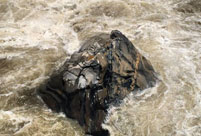 Luoyang aims to become 'Chinese Culture City'
Luoyang aims to become 'Chinese Culture City'
 Century-old jade disc found confirms ancient legend
Century-old jade disc found confirms ancient legend
 A serious mind behind Chinese leader
A serious mind behind Chinese leader
 Panda Cubs to Predict 2014 World Cup Winners
Panda Cubs to Predict 2014 World Cup Winners
 China Southern Airlines flight attendants win titles in service contest
China Southern Airlines flight attendants win titles in service contest
 Pupil's performance art persuades people to stop smoking
Pupil's performance art persuades people to stop smoking
 Nie Chenxi's clay tigers
Nie Chenxi's clay tigers
 Children's Day wishes
Children's Day wishes
 Chinese Kung Fu charms Silicon Valley
Chinese Kung Fu charms Silicon Valley
 Tranquil Yankou ancient town
Tranquil Yankou ancient town
 |
| (Xinhua Photo) |
BEIJING, June 8 -- China's Foreign Ministry released an article about the HYSY 981 drilling rig in the Xisha Islands on its website on Sunday. The full text is as follows:
The Operation of the HYSY 981 Drilling Rig: Vietnam's Provocation and China's Position
I. The operation of the HYSY 981 drilling rig
On 2 May 2014, a Chinese company's HYSY 981 drilling rig started its drilling operation inside the contiguous zone of China's Xisha Islands for the purpose of oil and gas exploration. With the first phase of the operation completed, the second phase began on 27 May. The two locations of operation are 17 nautical miles from both the Zhongjian Island of China's Xisha Islands and the baseline of the territorial waters of Xisha Islands, yet approximately 133 to 156 nautical miles away from the coast of the Vietnamese mainland.
The Chinese company has been conducting explorations in the related waters for the past 10 years, including seismic operations and well site surveys. The drilling operation carried out by HYSY 981 this time is a continuation of the routine process of explorations, and falls well within China's sovereignty and jurisdiction.
II. Vietnam's provocation
Shortly after the Chinese operation started, Vietnam sent a large number of vessels, including armed vessels, to the site, illegally and forcefully disrupting the Chinese operation and ramming the Chinese government vessels on escort and security missions there. In the meantime, Vietnam also sent frogmen and other underwater agents to the area, and dropped large numbers of obstacles, including fishing nets and floating objects, in the waters. As of 5 pm on 7 June, there were as many as 63 Vietnamese vessels in the area at the peak, attempting to break through China's cordon and ramming the Chinese government ships for a total of 1,416 times.
The above-mentioned actions of the Vietnamese side were serious infringements upon China's sovereignty, sovereign rights and jurisdiction, grave threats to the safety of Chinese personnel and the HYSY 981 drilling rig, and gross violations of the relevant international laws, including the Charter of the United Nations, the 1982 UN Convention on the Law of the Sea (UNCLOS) and 1988 Convention for the Suppression of Unlawful Acts against the Safety of Maritime Navigation and the Protocol for the Suppression of Unlawful Acts against the Safety of Fixed Platforms Located on the Continental Shelf. Such actions also undermined the freedom and safety of navigation in these waters, and damaged peace and stability in the region.
While illegally and forcefully disrupting the normal operation of the Chinese company on the sea, Vietnam also condoned anti-China demonstrations at home. In mid-May, thousands of lawless elements in Vietnam conducted beating, smashing, looting and arson against companies of China and several other countries. They brutally killed four Chinese nationals and injured over 300 others, and caused heavy property losses.
III. China's response
The waters between China's Xisha Islands and the coast of the Vietnamese mainland are yet to be delimited. The two sides have not yet conducted delimitation of the Exclusive Economic Zone (EEZ) and continental shelf in these waters. Both sides are entitled to claim EEZ and continental shelf in accordance with the UNCLOS. However, these waters will never become Vietnam's EEZ and continental shelf no matter which principle is applied in the delimitation.
In the face of Vietnam's provocative actions on the sea, China exercised great restraint and took necessary preventive measures. Chinese government ships were dispatched to the site for the purpose of ensuring the safety of the operation, which effectively safeguarded the order of production and operation on the sea and the safety of navigation. In the meantime, since 2 May, China has conducted over 30 communications with Vietnam at various levels, requesting the Vietnamese side to stop its illegal disruption. Regrettably, however, the illegal disruption of the Vietnamese side is still continuing.
IV. Xisha Islands are part of the Chinese territory
1. Xisha Islands are an inherent part of China's territory, over which there is no dispute.China was the first to discover, develop, exploit and exercise jurisdiction over the Xisha Islands. During the Northern Song Dynasty (960-1126 AD), the Chinese government already established jurisdiction over the Xisha Islands and sent naval forces to patrol the waters there. In 1909, Commander Li Zhun of the Guangdong naval force of the Qing Dynasty led a military inspection mission to the Xisha Islands and reasserted China's sovereignty by hoisting the flag and firing a salvo on the Yongxing Island. In 1911, the government of the Republic of China announced its decision to put the Xisha Islands and their adjacent waters under the jurisdiction of Ya County of Hainan Island.
Japan invaded and occupied the Xisha Islands during the Second World War. After Japan's surrender in 1945, in accordance with a series of international documents, the Chinese government sent senior officials boarding military vessels to the Xisha Islands in November 1946 to hold the ceremony for receiving the islands, and a stone tablet was erected to commemorate the handover and troops were stationed there afterwards. The Xisha Islands, which had once been illegally occupied by a foreign country, were thus returned to the jurisdiction of the Chinese government.
In 1959, the Chinese government established the Administration Office for the Xisha, Zhongsha and Nansha Islands. In January 1974, the Chinese military and people drove the invading army of the Saigon authority of South Vietnam from the Shanhu Island and Ganquan Island of the Xisha Islands and defended China's territory and sovereignty. The Chinese government enacted the Law of the People's Republic of China on the Territorial Sea and the Contiguous Zone in 1992 and published the base points and baselines of the territorial waters of the Xisha Islands in 1996, both of which reaffirm China's sovereignty over the Xisha Islands and the extent of territorial waters of the islands. In 2012, the Chinese government established the various departments of Sansha city on the Yongxing Island of Xisha Islands.
2. Prior to 1974, none of the successive Vietnamese governments had ever challenged China's sovereignty over the Xisha Islands. Vietnam had officially recognized the Xisha Islands as part of China's territory since ancient times. This position was reflected in its government statements and notes as well as its newspapers, maps and textbooks.
During a meeting with charge d'affaires ad interim Li Zhimin of the Chinese Embassy in Vietnam on 15 June 1956, Vice Foreign Minister of the Democratic Republic of Vietnam Ung Van Khiem solemnly stated that, "according to Vietnamese data, the Xisha Islands and Nansha Islands are historically part of Chinese territory." Le Loc, Acting Director of the Asian Department of the Vietnamese Foreign Ministry, who was present, specifically cited Vietnamese data and pointed out that, "judging from history, these islands were already part of China at the time of the Song Dynasty."
On 4 September 1958, the Chinese government issued a declaration, stating that the breadth of the territorial waters of the People's Republic of China shall be 12 nautical miles and making it clear that "this provision applies to all the territories of the People's Republic of China, including ... the Xisha Islands". On 6 September, NHAN DAN, the official newspaper of the Central Committee of Vietnamese Workers' Party, published on its front page the full text of the Chinese government's declaration regarding China's territorial sea. On 14 September, Premier Pham Van Dong of the government of Vietnam sent a diplomatic note to Premier Zhou Enlai of the State Council of China, solemnly stating that "the government of the Democratic Republic of Vietnam recognizes and supports the declaration of the government of the People's Republic of China on its decision concerning China's territorial sea made on September 4, 1958" and "the government of the Democratic Republic of Vietnam respects this decision".
On 9 May 1965, the government of the Democratic Republic of Vietnam issued a statement with reference to the designation by the US government of the "combat zone" of the US armed forces in Vietnam. It says, "US President Lyndon Johnson designated the whole of Vietnam, and the adjacent waters which extend roughly 100 miles from the coast of Vietnam and part of the territorial waters of the People's Republic of China in its Xisha Islands as 'combat zone' of the United States armed forces ... in direct threat to the security of the Democratic Republic of Vietnam and its neighbors ..."
The World Atlas printed in May 1972 by the Bureau of Survey and Cartography under the Office of the Premier of Vietnam designated the Xisha Islands by their Chinese names. The geography textbook for ninth graders published by Vietnam's Educational Press in 1974 carried in it a lesson entitled "The People's Republic of China". It reads, "The chain of islands from the Nansha and Xisha Islands to Hainan Island, Taiwan Island, the Penghu Islands and the Zhoushan Islands ... are shaped like a bow and constitute a Great Wall defending the China mainland."
But now the Vietnamese government goes back on its word by making territorial claims over China's Xisha Islands. That is a gross violation of the principles of international law, including the principle of estoppel, and the basic norms governing international relations.
V. Properly addressing the situation
China is a staunch force for maintaining peace and stability in the South China Sea and promoting cooperation between and development of countries in the region. China firmly upholds the purpose and principles of the Charter of the United Nations, the basic norms of international relations and fundamental principles of international law. The least China wants is any turbulence in its neighborhood.
China wants good relations with Vietnam, but there are principles that China cannot abandon. The channel of communication between China and Vietnam is open. China urges Vietnam to bear in mind the overall interests of the bilateral relations and peace and stability in the South China Sea, respect China's sovereignty, sovereign rights and jurisdiction, immediately stop all forms of disruptions of the Chinese operation and withdraw all vessels and personnel from the site, so as to ease the tension and restore tranquility at sea as early as possible. China will continue its effort to communicate with Vietnam with a view to properly addressing the current situation.
 Magnificent Hutiao Gorge
Magnificent Hutiao Gorge  Heat waves hit China
Heat waves hit China Love at the construction site
Love at the construction site Graduation photos bring memories back to life
Graduation photos bring memories back to life Art school students present works in Nanjing
Art school students present works in Nanjing Xinjiang's first high-speed railway goes on trial run
Xinjiang's first high-speed railway goes on trial run 3D Sea-life Themed Art Garage unveiled in Zhengzhou
3D Sea-life Themed Art Garage unveiled in Zhengzhou
 Creative Photos go viral during graduation season
Creative Photos go viral during graduation season Students in last-minute effort for Gaokao
Students in last-minute effort for Gaokao Dali, an ideal summer vacation destination
Dali, an ideal summer vacation destination Xichan Temple's little monk hit the Internet
Xichan Temple's little monk hit the Internet Monologue of a modern dancer
Monologue of a modern dancer College girl proposes to boyfriend on Weibo
College girl proposes to boyfriend on Weibo Special operation members in counter-terrorism training
Special operation members in counter-terrorism training American football brings manhood out of boys
American football brings manhood out of boysDay|Week|Month